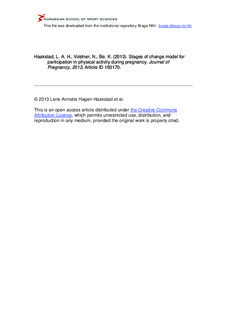| dc.contributor.author | Haakstad, Lene Annette Hagen | |
| dc.contributor.author | Voldner, Nanna | |
| dc.contributor.author | Bø, Kari | |
| dc.date.accessioned | 2013-04-11T06:50:50Z | |
| dc.date.available | 2013-04-11T06:50:50Z | |
| dc.date.issued | 2013 | |
| dc.identifier | Seksjon for idrettsmedisinske fag / Department of Sports Sciences | |
| dc.identifier.citation | Journal of Pregnancy. 2013, 2013, article ID 193170 | no_NO |
| dc.identifier.issn | 2090-2735 | |
| dc.identifier.uri | http://hdl.handle.net/11250/171116 | |
| dc.description | Copyright © 2013 Lene Annette Hagen Haakstad et al. This is an open access article distributed under the Creative Commons Attribution License, which permits unrestricted use, distribution, and reproduction in any medium, provided the original work is properly cited. | no_NO |
| dc.description.abstract | Background. The transtheoretical model (TTM) has been successful in promoting health behavioral change in the general population. However, there is a scant knowledge about physical activity in relation to the TTM during pregnancy. Hence, the aims of the present study were (1) to assess readiness to become or stay physically active according to the TTM and (2) to compare background and health variables across the TTM. Methods. Healthy pregnant women () were allocated to the study from Oslo University Hospital, Norway. The participants filled in a validated self-administered questionnaire, physical activity pregnancy questionnaire (PAPQ) in gestation, weeks 32–36. The questionnaire contained 53 questions with one particular question addressing the TTM and the five stages: (1) precontemplation stage, (2) contemplation stage, (3) preparation stage, (4) action stage, and (5) maintenance stage. Results. More than half of the participants (53%) were involved in regular exercise (stages 4-5); however, only six specified that they had recently started an exercise program (stage 4). About 33% reported engaging in some physical activity, but not regularly (stage 3). The results showed that receiving advice from health professionals to exercise during pregnancy increased the likeliness of being in stages 4-5, while higher age, multiparity, pregravid overweight, unhealthy eating habits, pelvic girdle pain, and urinary incontinence were more prevalent with low readiness to change exercise habits (stages 1–3). Conclusion. According to the TTM, more than half of the participants reported to be physically active. Moreover, most of the participants classified as inactive showed a high motivational readiness or intention to increase their physical activity level. Hence, pregnancy may be a window of opportunity for the establishment of long-term physical activity habits. | no_NO |
| dc.language.iso | eng | no_NO |
| dc.publisher | Hindawi Publishing Corporation | no_NO |
| dc.subject | adult | |
| dc.subject | demography | |
| dc.subject | female | |
| dc.subject | health status disparities | |
| dc.subject | humans | |
| dc.subject | models, theoretical | |
| dc.subject | monitoring, psychologic | |
| dc.subject | motor activity | |
| dc.subject | Norway | |
| dc.subject | patient education as topic / methods | |
| dc.subject | patient participation | |
| dc.subject | physical education and training / standards / statistics & numerical data | |
| dc.subject | pregnancy | |
| dc.subject | pregnancy trimesters / physiology / psychology | |
| dc.subject | pregnant women | |
| dc.subject | questionnaires | |
| dc.subject | sosioeconomic factors | |
| dc.title | Stages of change model for participation in physical activity during pregnancy | no_NO |
| dc.type | Journal article | no_NO |
| dc.type | Peer reviewed | no_NO |
| dc.subject.nsi | VDP::Medical disciplines: 700::Clinical medical disciplines: 750::Gynecology and obstetrics: 756 | no_NO |
| dc.source.journal | Journal of Pregnancy | |
| dc.identifier.doi | 10.1155/2013/193170 | |
